Today, we will explore 20 great Indian discoveries and inventions that still impact the lives of billions of people around the world.
Ancient India was one of the pioneers of science in the world. If we talk about Indian discoveries and inventions, namely Agriculture, Astronomy, Architecture, Metallurgy, Mathematics or Medicine, India was at the forefront, especially when compared to other countries.
On top of that, India is the most ancient civilization in the whole world. It won’t be wrong to say that owing to so many ancient Indian inventions, the modern world is able to reach the Moon and now gearing to reach Mars.
We are sure you are amazed!
Top 20 Great Indian Discoveries & Inventions
1. The “ZERO”

One of the great Indian discoveries that transformed mathematics is the invention of zero, attributed to the ancient Indian mathematician Aryabhatta. Born in 476 CE, Aryabhatta made significant contributions to mathematics and astronomy. His work, particularly in the numeral system, introduced the concept of zero as a placeholder, revolutionizing how we understand and perform calculations today.
Before the advent of zero, numbers were represented without a clear way to denote the absence of a value, making mathematical operations cumbersome. Aryabhatta’s introduction of zero allowed for the development of a positional number system, facilitating complex calculations and enabling advancements in arithmetic, algebra, and even calculus. This innovation laid the groundwork for modern mathematics and greatly influenced other cultures, especially during the spread of Indian numerals through trade and scholarship.
Moreover, Aryabhatta’s insights into astronomy and his methods for calculating the circumference of the Earth further showcase the depth of Indian intellectual achievements. The legacy of zero and Aryabhatta’s work exemplifies the profound impact of Indian scholars on global mathematics, underscoring the significance of great Indian discoveries in shaping the world we live in today.
2. Decimal System

Among the great Indian discoveries that have profoundly influenced mathematics is the invention of the decimal system and the place value system, believed to have emerged around 100 B.C. This innovative numeral system transformed the way we approach mathematics, allowing for more efficient calculations and better organization of numerical data.
The decimal system, based on powers of ten, simplifies arithmetic operations by using ten digits (0-9) to represent all numbers. This system allows for the easy representation of large numbers and facilitates straightforward mathematical calculations. The introduction of the place value system further enhanced this concept by assigning value to each digit based on its position. For instance, in the number 345, the ‘3’ represents three hundred, the ‘4’ represents forty, and the ‘5’ represents five.
This revolutionary approach to numeration was a significant departure from earlier systems and laid the foundation for modern mathematics. Indian scholars, including prominent figures like Aryabhatta and Brahmagupta, contributed to the refinement and dissemination of these concepts. The decimal and place value systems are now integral to mathematics worldwide, showcasing the lasting impact of great Indian discoveries on global civilization.
3. Mathematics

The development of Algebra, Calculus, and Trigonometry marks some of the great Indian discoveries that have significantly shaped modern mathematics. Indian mathematicians made profound contributions to these fields, establishing foundational principles that are still in use today.
Algebra’s roots in India can be traced back to the works of scholars like Brahmagupta in the 7th century, who formulated rules for solving quadratic equations and provided methods for dealing with negative numbers. His treatise, “Brahmasphutasiddhanta,” laid the groundwork for algebraic concepts that later influenced mathematicians worldwide.
Calculus, although widely credited to European mathematicians, also has its origins in Indian mathematics. The mathematician Madhava of Sangamagrama, in the 14th century, developed concepts of infinite series and early forms of calculus, anticipating ideas that would later be formalized in the work of Newton and Leibniz.
Trigonometry, too, saw significant advancements in India, with Aryabhata and others developing sine and cosine functions long before they became prevalent in the West. These great Indian discoveries not only highlight India’s rich mathematical heritage but also emphasize the country’s vital role in the evolution of mathematical thought across the globe.
4. Chess
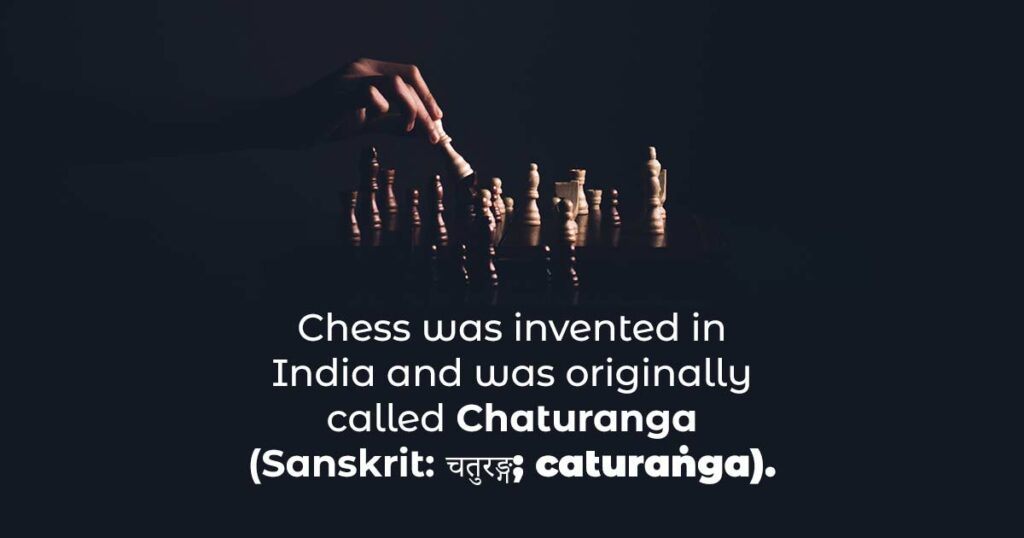
Among the great Indian discoveries is the invention of chess, a game that has fascinated and challenged players for centuries. Originally known as Chaturanga, chess emerged in India around the 6th century AD. This ancient game was more than just a pastime; it served as a strategic exercise for military leaders, reflecting the complexities of warfare and tactics.
Chaturanga featured pieces that represented different military units: infantry, cavalry, elephants, and chariots. The game’s design and rules encouraged critical thinking and strategic planning, laying the groundwork for future developments in board games. Over time, Chaturanga spread to other regions, adapting and evolving along the way.
The modern version of chess, which we recognize today, was significantly influenced by the Persians, who encountered the game as it traveled along trade routes. They modified the rules and names of the pieces, leading to the game’s widespread popularity in the Islamic world and eventually in Europe.
Chess’s rich history from Chaturanga to its contemporary form underscores the significance of these great Indian discoveries in shaping global culture and intellectual thought. Today, chess remains a symbol of strategic prowess and mental agility, enjoyed by millions around the world.
5. Yoga
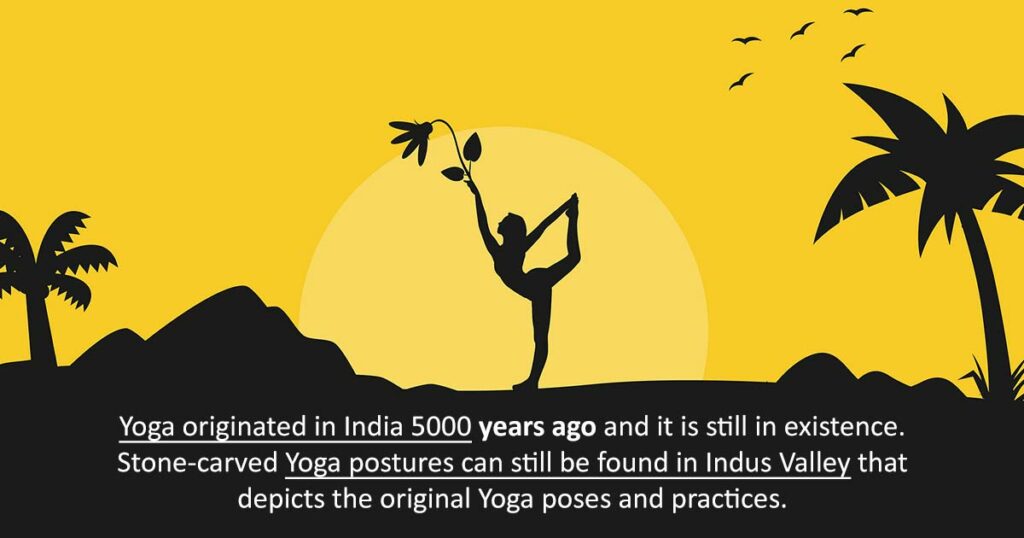
Yoga, a profound practice that originated in India over 5,000 years ago, is one of the great Indian discoveries that continues to thrive in modern times. Rooted in ancient philosophy and spirituality, yoga encompasses a holistic approach to physical, mental, and spiritual well-being. Its enduring presence in contemporary society speaks to its universal appeal and transformative potential.
Archaeological evidence, including stone-carved figures from the Indus Valley Civilization, showcases early yoga postures and practices. These carvings depict individuals in various asanas (postures), indicating that the principles of yoga were not only theoretical but also actively practiced. This historical connection highlights the depth of India’s contribution to wellness and self-discovery.
As yoga spread beyond India’s borders, it adapted to various cultures while retaining its core principles of balance, mindfulness, and harmony. Today, yoga is embraced worldwide, practiced by millions seeking physical fitness, mental clarity, and spiritual growth.
The practice has also been recognized for its health benefits, making it an integral part of holistic health approaches globally. The legacy of yoga exemplifies the profound impact of great Indian discoveries on both individual lives and global wellness traditions.
6. Ayurveda

Ayurveda, the ancient system of medicine that emphasizes holistic health and well-being, is another of the great Indian discoveries that originated around 5,000 years ago. Rooted in the Vedic texts, Ayurveda translates to “the science of life” and is based on the belief that health is a balance of the body, mind, and spirit.
This comprehensive approach to wellness emphasizes prevention and the treatment of ailments through natural means, including herbal remedies, dietary adjustments, and lifestyle modifications. Ayurveda identifies three primary doshas—Vata, Pitta, and Kapha—that represent different physical and psychological characteristics. By understanding one’s dosha, individuals can tailor their diets and practices to achieve optimal health.
Archaeological evidence and ancient texts reveal that Ayurvedic practices were highly advanced, with detailed knowledge of anatomy, surgery, and herbal medicine. The system promotes a deep connection with nature and emphasizes the importance of a balanced lifestyle for maintaining health.
Today, Ayurveda has gained global recognition as a valuable alternative to conventional medicine, offering insights into preventive care and holistic healing. Its enduring relevance and widespread practice underscore the significance of great Indian discoveries in promoting health and wellness across cultures and generations.
7. World’s First University
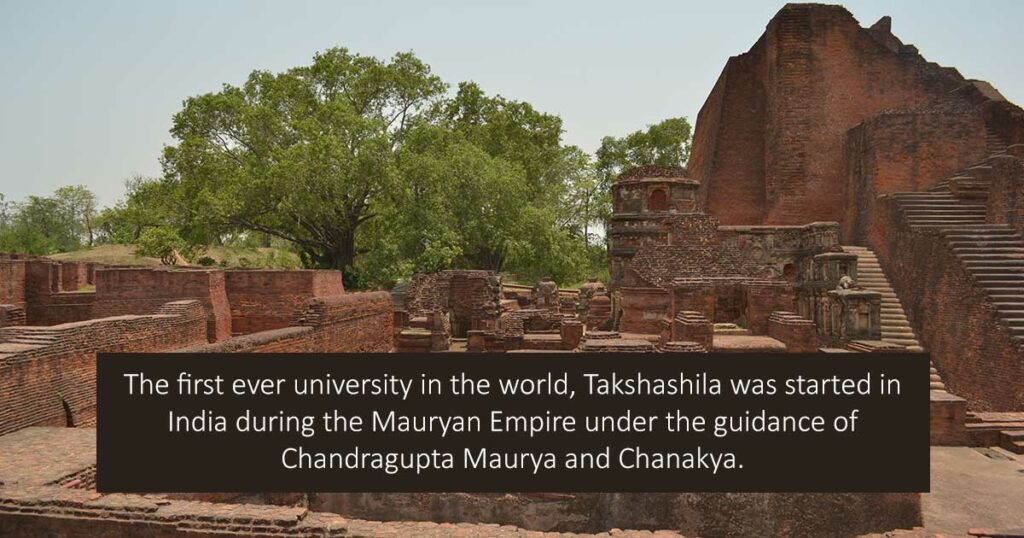
The establishment of Takshashila, often regarded as the first university in the world, is one of the great Indian discoveries that reflects India’s rich intellectual heritage. Founded during the Mauryan Empire around the 6th century BCE, Takshashila served as a prominent center for learning, attracting students from various parts of the world.
Under the guidance of notable figures such as Chandragupta Maurya and his mentor Chanakya, Takshashila flourished as a hub of knowledge, offering a wide array of subjects, including philosophy, medicine, mathematics, and military strategy. This early institution emphasized a comprehensive education, combining practical skills with theoretical understanding, and set the foundation for higher education systems globally.
Students at Takshashila were exposed to diverse ideas and cultures, fostering an environment of intellectual exchange. The university’s legacy is evident in the numerous scholars and thinkers it produced, who went on to make significant contributions to various fields.
Today, Takshashila stands as a symbol of India’s long-standing commitment to education and knowledge dissemination. Its historical significance underscores the impact of great Indian discoveries on the development of educational institutions worldwide, shaping the way knowledge is imparted and pursued.
8. Origin of Buddhism and Jainism

Buddhism and Jainism are two profound religions that originated in India, specifically in the region of Magadha (modern-day Bihar), and both continue to thrive in the modern age. These faiths emerged around the 6th century BCE, during a period of significant philosophical and spiritual exploration.
Buddhism was founded by Siddhartha Gautama, known as the Buddha, who sought to understand the nature of suffering and the path to enlightenment. His teachings emphasized the Four Noble Truths and the Eightfold Path, offering a comprehensive framework for spiritual development and ethical living. Today, Buddhism has spread across the globe, with millions of followers who practice mindfulness, meditation, and compassion.
Jainism, on the other hand, was established by Mahavira, who reinforced principles of non-violence (ahimsa), truth, and asceticism. Jain teachings advocate for the liberation of the soul through self-discipline and respect for all living beings. Jainism has a rich tradition of rituals and community practices that continue to flourish, particularly in India.
Both religions have profoundly influenced Indian culture, philosophy, and ethics. Their emphasis on non-violence, compassion, and spiritual growth resonates with people worldwide, highlighting the significance of these great Indian discoveries in promoting harmony and understanding across diverse cultures.
9. Snakes and Ladders
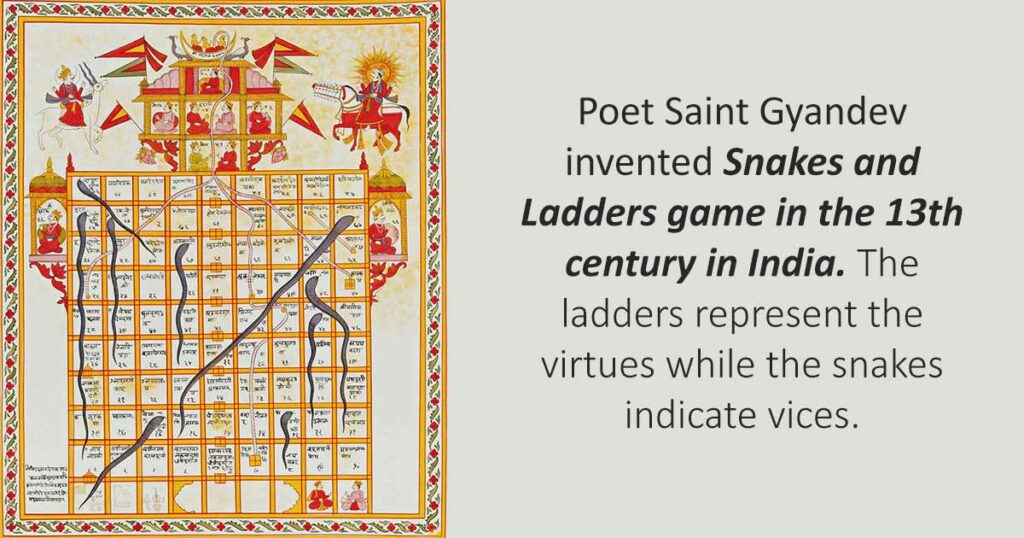
The game of Snakes and Ladders, known for its simple yet engaging gameplay, was invented in India by the poet-saint Gyandev in the 13th century. This game, originally called “Moksha Patamu,” carries deep philosophical meanings that reflect the moral teachings of its time.
In Snakes and Ladders, the ladders symbolize virtues such as honesty, generosity, and faith, representing the spiritual ascent toward enlightenment and ultimate liberation (moksha). Conversely, the snakes signify vices like greed, anger, and ignorance, illustrating the obstacles and pitfalls that can hinder one’s spiritual journey. Players navigate the board, climbing ladders and sliding down snakes, which serves as a metaphor for the ups and downs of life.
Originally designed as a tool for moral instruction, the game aimed to teach players about the consequences of their actions and the importance of virtuous living. Over time, Snakes and Ladders transcended its educational roots, evolving into a beloved pastime enjoyed by people of all ages around the world. This enduring legacy highlights one of the great Indian discoveries that blend entertainment with valuable life lessons, emphasizing the rich cultural heritage of India.
10. Plastic surgery

Plastic surgery, a field often associated with modern medical advancements, has roots that trace back to ancient India, where it was practiced as early as 2000 BC. At the forefront of this pioneering work was Sushruta, a revered physician known as the “father of surgery“, who lived around 600 BC. His contributions to plastic and cataract surgery are documented in the ancient text Sushruta Samhita, a comprehensive treatise that outlines surgical techniques, instruments, and patient care.
Sushruta’s innovative methods included procedures for reconstructing the nose, repairing damaged ears, and treating various injuries. His meticulous approach to surgery emphasized hygiene, anesthesia, and the use of specific tools, setting a standard for surgical practice. The detailed descriptions in the Sushruta Samhita not only influenced the practice of surgery in India but also laid the groundwork for future advancements in Europe and beyond.
The principles established by Sushruta resonate in modern plastic surgery, highlighting the remarkable foresight of ancient Indian medicine. His work exemplifies one of the great Indian discoveries that continue to impact medical practices today, showcasing the depth of India’s contributions to global health and science.
11. Super Computer

India’s remarkable achievement in the field of computing is exemplified by its capability to build supercomputers indigenously, placing it alongside the U.S. and Japan as one of the few countries with this expertise. This technological milestone is a testament to India’s growing prowess in science and engineering.
The development of India’s supercomputers began with the PARAM series in the late 1980s, spearheaded by the Centre for Development of Advanced Computing (C-DAC). These early machines laid the foundation for subsequent advancements in high-performance computing, enabling India to tackle complex scientific problems and data-intensive research across various fields, including climate modelling, molecular biology, and computational fluid dynamics.
In recent years, India has continued to push the boundaries of supercomputing with projects like the Pratyush and Mihir systems, which rank among the fastest supercomputers in the world. These systems not only demonstrate India’s technical capabilities but also support critical applications in weather forecasting, disaster management, and national security.
This ability to develop supercomputers indigenously highlights India’s commitment to self-reliance in technology and innovation, reflecting one of the great Indian discoveries in the realm of modern science and engineering.
12. Wireless Communication
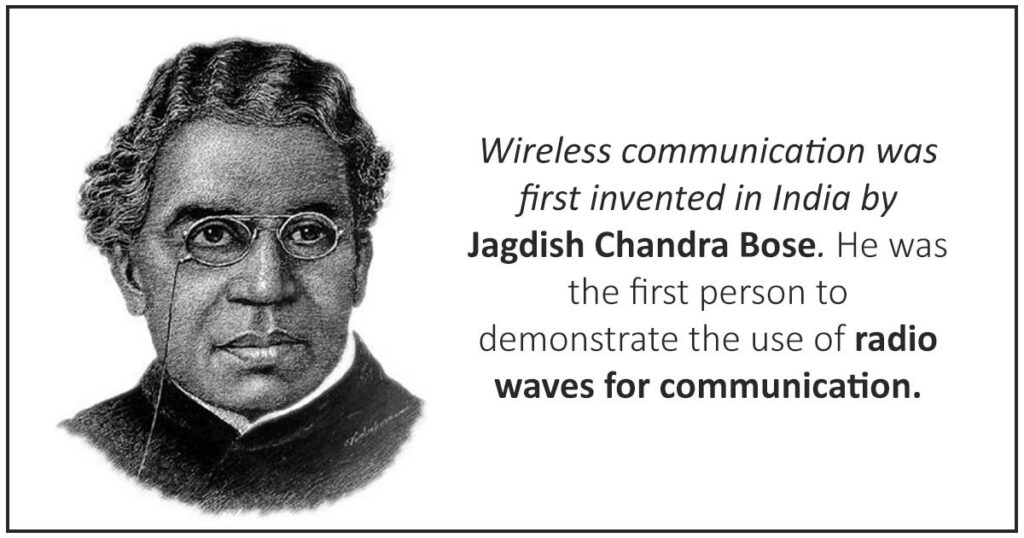
Wireless communication, a cornerstone of modern technology, was first pioneered in India by the illustrious scientist Jagdish Chandra Bose. In the late 19th century, Bose made groundbreaking contributions to the field of radio waves, demonstrating their potential for communication. His experiments in 1895 showcased the ability to transmit signals without the use of wires, laying the groundwork for future advancements in wireless technology.
Bose’s work involved the use of millimeter waves to create signals that could be transmitted over short distances. He constructed an early version of a coherer—a device used to detect radio waves—and conducted experiments that successfully demonstrated wireless transmission. His pioneering efforts went largely unrecognized at the time, overshadowed by contemporaries in the West, yet they were pivotal in shaping the future of telecommunications.
Bose’s contributions extend beyond wireless communication; he was also a significant figure in plant physiology and the study of biophysics. His innovative spirit exemplifies one of the great Indian discoveries, highlighting India’s early involvement in scientific exploration and its influence on global technological advancements. Today, the legacy of his work continues to resonate in the field of wireless communication, which is fundamental to modern connectivity.
13. Leprosy and Lithiasis Cure
India has a rich history of medicinal practices, including early treatments for various diseases such as leprosy and lithiasis (the formation of stones in the body). Notably, the Atharva Veda, one of the oldest sacred texts dating back to approximately 1500–1200 BCE, contains references to remedies for these conditions, showcasing the advanced understanding of health and healing in ancient Indian society.
While the specific name of the inventor behind these cures remains unknown, the inclusion of such treatments in the Atharva Veda highlights the significance of traditional Indian medicine, which emphasized herbal remedies and holistic approaches to health. Ancient texts indicate that various plants and natural substances were utilized to create effective remedies, reflecting a deep knowledge of botany and human anatomy.
The historical significance of these cures demonstrates the innovative spirit of ancient Indian scholars and physicians. Their contributions to medicine laid the foundation for future advancements and continue to influence contemporary medical practices. This legacy is part of the great Indian discoveries that underscore India’s long-standing tradition of healthcare and its role in the evolution of medical knowledge worldwide.
14. The USB (Universal Serial Bus)

Ajay V. Bhatt, an accomplished engineer and computer architect, is best known for inventing the Universal Serial Bus (USB), a groundbreaking technology that revolutionized the way we connect and transfer data between devices. Developed in the mid-1990s, the USB standard was designed to simplify the process of connecting various peripherals—such as keyboards, mice, printers, and external storage devices—allowing for faster and more efficient data transfer.
The USB’s user-friendly design made it possible to easily plug in devices without the need for complicated installations or configurations, which greatly enhanced user experience. This innovation not only streamlined the way we interact with technology but also provided a reliable means for transferring large amounts of data. As a result, USBs have become an essential part of everyday life, with applications in personal computing, data storage, and even mobile devices.
Ajay V. Bhatt’s contributions to the development of the USB have earned him numerous accolades, recognizing his pivotal role in shaping modern computing. The USB remains one of the great Indian discoveries, exemplifying how innovation can lead to significant advancements in technology and improve the way we manage and share information globally.
15. Computer Software

India stands as one of the largest providers of computer software globally, showcasing its prowess in technology and innovation. With a vibrant IT industry that has flourished since the late 20th century, India has positioned itself as a major player in software development and services. The country is home to a vast pool of skilled engineers and developers, enabling it to cater to diverse software needs across various sectors, including finance, healthcare, education, and e-commerce.
More than 90 countries purchase software from India, reflecting the trust and reliability that Indian companies have built over the years. Indian software firms are renowned for their ability to deliver high-quality solutions at competitive prices, making them attractive partners for businesses worldwide. This global reach has not only boosted India’s economy but has also played a vital role in transforming the country’s image as a technology hub.
The software industry has contributed significantly to India’s GDP, generating millions of jobs and fostering entrepreneurship. This growth emphasizes one of the great Indian discoveries in the realm of information technology, highlighting how India has leveraged its intellectual resources to become a leader in the global software market.
16. The Science Day
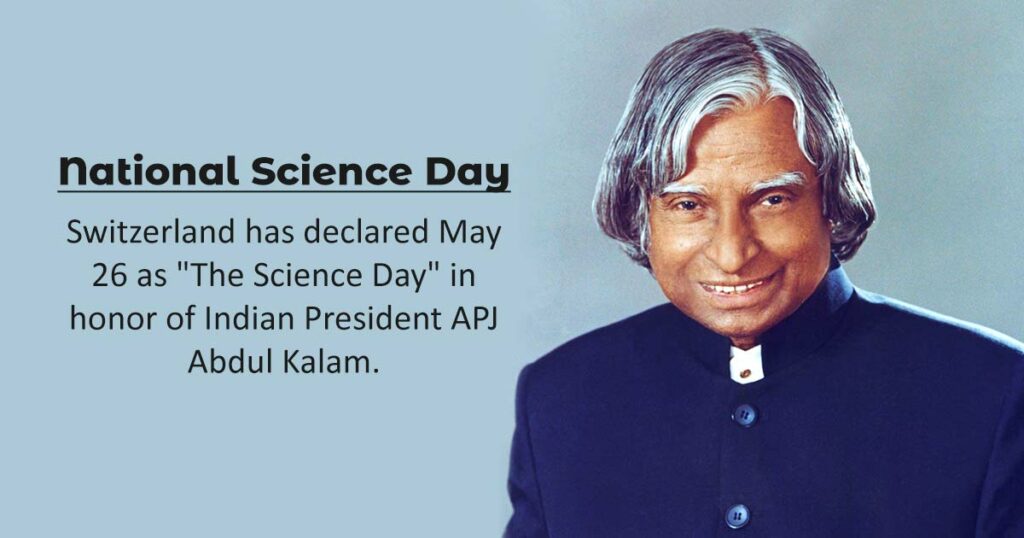
Switzerland has recognized May 26 as “The Science Day” in honor of Dr. A.P.J. Abdul Kalam, the former President of India and a renowned scientist. This tribute reflects the immense respect and admiration that Dr. Kalam garnered for his significant contributions to science and technology, particularly in the field of aerospace engineering and missile development.
Dr. Kalam, often referred to as the “Missile Man of India,” played a crucial role in India’s space and defense programs, including the development of the Agni and Prithvi missiles. His vision and leadership inspired a generation of scientists and engineers, not only in India but across the globe. Beyond his scientific achievements, Dr. Kalam was also a passionate advocate for education and youth empowerment, encouraging students to pursue careers in science and innovation.
The declaration of “The Science Day” serves as a reminder of Dr. Kalam’s legacy and his commitment to advancing scientific knowledge for the betterment of humanity. This honor highlights the impact of his work and the importance of fostering scientific curiosity and exploration, exemplifying one of the great Indian discoveries in the realm of global scientific collaboration and inspiration.
17. Natural Fiber
Natural fibers like jute, cotton, and wool have their origins in India, dating back to the Indus Valley Civilization, one of the world’s earliest urban cultures that flourished around 2500 BCE. This civilization is renowned for its advanced textile production, which played a significant role in trade and daily life.
Cotton, in particular, was cultivated and woven into fabric in ancient India, making it one of the first places in the world to use this versatile fiber. Archaeological findings, including cotton remnants discovered in Mohenjo-Daro and Harappa, showcase the high level of skill and craftsmanship in textile production during this period. The techniques developed then laid the groundwork for the global cotton industry we see today.
Jute, known for its strength and durability, also has roots in India, where it was traditionally used for making ropes, bags, and various household items. The country continues to be one of the largest producers of jute in the world.
Wool was used for textiles as well, particularly in regions with a cooler climate. The ability to weave and dye fibers into intricate patterns demonstrated the advanced artistry and cultural significance of textiles in ancient Indian society.
The legacy of these natural fibers reflects one of the great Indian discoveries, highlighting India’s rich heritage in textile innovation and its lasting impact on global fashion and trade.
18. Buttons

Buttons, a fundamental component of clothing today, were first invented in India during the Indus Valley Civilization around 2000 BCE. This early civilization, known for its advanced urban planning and craftsmanship, showcased remarkable ingenuity in textile production and adornment.
Archaeological discoveries from sites like Mohenjo-Daro and Harappa reveal that buttons were made from seashells, shaped into geometric forms, and featured tiny holes bored into them. This innovative design allowed them to be sewn onto garments, serving both functional and decorative purposes. The use of buttons in clothing not only enhanced the practicality of garments but also reflected the aesthetic sensibilities of the time.
The craftsmanship involved in creating these early buttons highlights the sophistication of Indus Valley artisans, who demonstrated skill in manipulating natural materials to create useful and beautiful objects. This tradition of textile innovation laid the groundwork for future developments in clothing and fashion.
The invention of buttons exemplifies one of the great Indian discoveries, illustrating how ancient India contributed to everyday objects that continue to play an essential role in modern apparel. This legacy of creativity and craftsmanship underscores the cultural richness and technological advancements of early Indian society.
19. Shampoo

The term “shampoo” is derived from the word “champoo,” which has its origins in India, where the practice of using herbal pastes and oils for cleansing hair dates back centuries. The modern concept of shampoo was first formalized in 1762 in the eastern parts of India, particularly in Bengal, where local practitioners began to refine the process of hair cleansing.
Originally, “champoo” referred to a massage of the scalp using a blend of herbs, oils, and other natural ingredients. This practice was not only aimed at cleaning hair but also at promoting relaxation and overall well-being. Traditional Indian hair care often included ingredients like soapnut (reetha), shikakai, and various oils, which were known for their nourishing properties.
The introduction of shampoo to the Western world marked a significant evolution in hair care. British colonizers, impressed by the effectiveness of these natural cleansing methods, adapted and commercialized them, leading to the development of the modern shampoo we use today.
This transition highlights one of the great Indian discoveries, emphasizing the country’s rich heritage in natural remedies and beauty practices. The legacy of “champoo” underscores the importance of India’s contributions to global personal care and hygiene practices, showcasing the timeless wisdom of ancient Indian traditions.
20. The Baily Bridge
The Baily Bridge, renowned as the “highest bridge in the world,” was constructed by the Indian Army in the challenging terrain of the Himalayan region. Completed in 1982, this remarkable engineering feat spans the Shyok River in Ladakh, connecting the regions of Nubra Valley and the Siachen Glacier.
Designed to be a temporary yet robust structure, the Baily Bridge exemplifies the ingenuity and resilience of the Indian Army. It was built using pre-fabricated sections that could be assembled quickly, making it a vital asset for military logistics and transportation in an area with harsh weather conditions and difficult access. The bridge has a height of approximately 5,602 meters (18,379 feet) above sea level, making it the highest of its kind in the world.
The construction of the Baily Bridge not only facilitated the movement of troops and supplies but also improved connectivity for local communities, significantly enhancing accessibility in this remote region.
Its strategic importance and engineering brilliance underscore one of the great Indian discoveries in civil and military engineering, showcasing India’s capability to overcome geographical challenges through innovation and determination. The bridge stands as a testament to the skills and commitment of the Indian Army in ensuring connectivity and support in extreme conditions.
Also read: 20 Amazing Facts About India
Conclusion
In conclusion, the Baily Bridge serves as a remarkable testament to the engineering prowess and strategic vision of the Indian Army, embodying one of the great Indian discoveries in infrastructure development. Its construction not only highlights the ability to overcome challenging geographical obstacles but also reflects a commitment to enhancing connectivity and accessibility in remote regions.
As the highest bridge in the world, the Baily Bridge stands as a symbol of innovation and resilience, reinforcing India’s legacy in engineering and its contributions to global infrastructure. This iconic structure continues to facilitate vital transport links and serves as an enduring example of India’s capability to meet the demands of both military and civilian needs in some of the harshest terrains on the planet.
How many of these great Indian discoveries and inventions did you already know?



